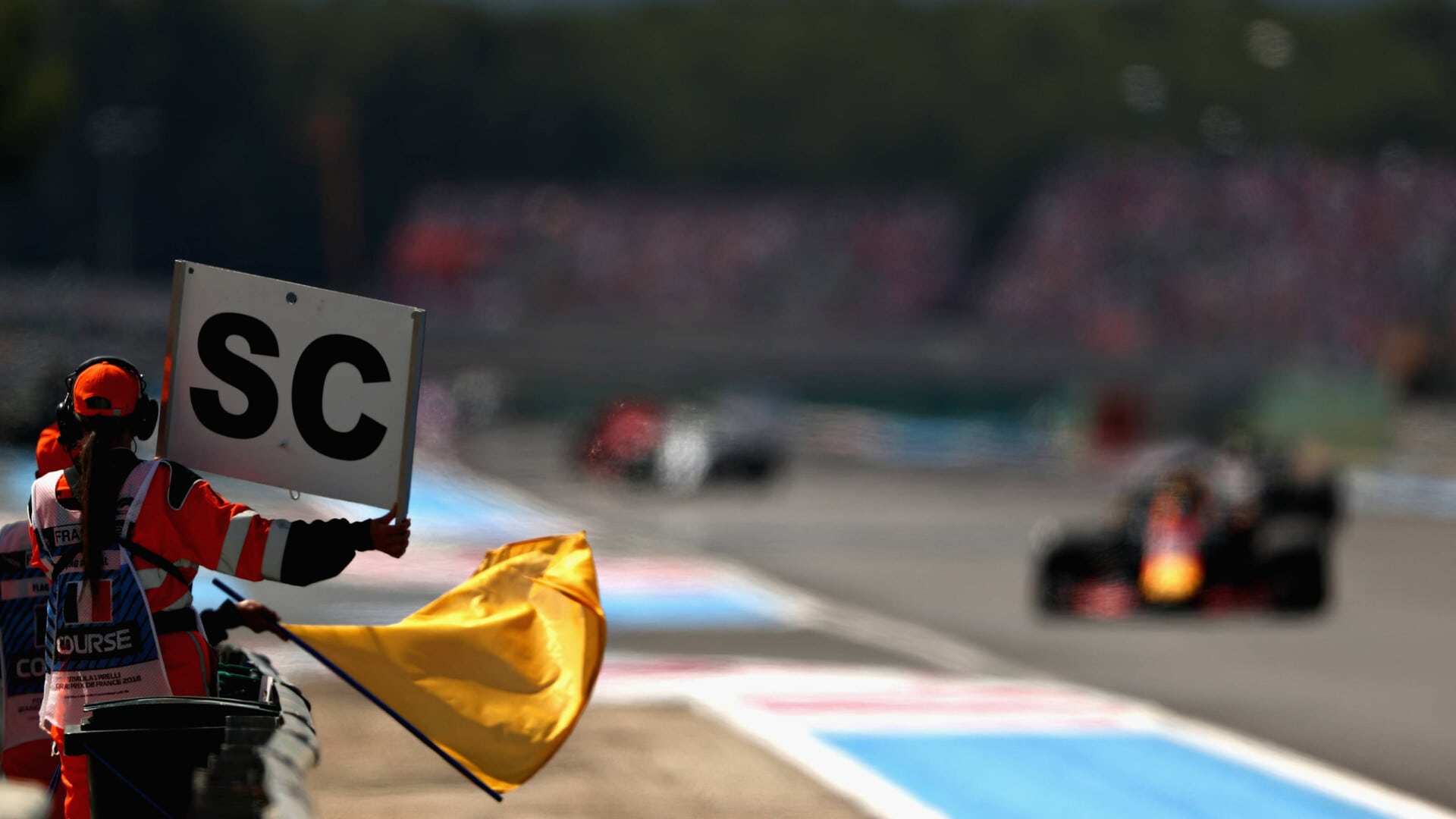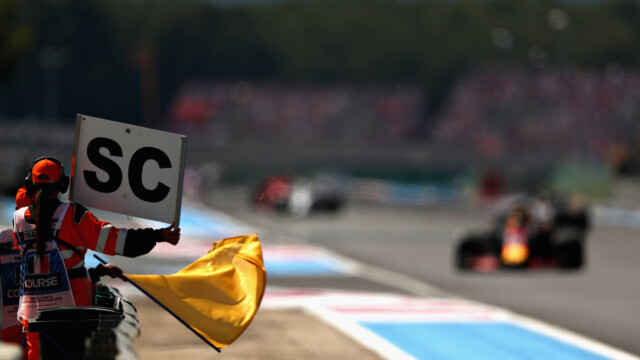F1 Flags Explained


While watching a Formula 1 race have you ever seen different coloured flags being waved during different phases of the race? Throughout this article, I’m going to be explaining what the colours or patterns actually mean and what they indicate to drivers and viewers.
While everyone knows the chequered flag signals the end of the race, in a Formula 1 race there are 10 flags that could possibly be waved/used to indicate important information to drivers during a Grand Prix. The main flags you’ll usually see on are the yellow, red, green and blue flags. However, other coloured and patterned flags can be used.
What do the different flags in F1 mean?
The yellow flags are usually seen the most during a Formula 1 session. This coloured flag basically means that there has been a hazard on the track. Whether that is a car has stopped on track, there was a crash and debris is covered across the track or a car goes into the barriers.
When under a yellow flag the drivers must reduce their speed and they will no longer be able to overtake. If a driver goes over the speed limit they could get a penalty. During qualifying sessions, if a yellow flag is waved drivers must abandon their flying laps. This can obviously compromise the driver’s qualifying session, even more so if it is their last flying lap before the qualifying session ends.
When a yellow flag is waved, many of the drivers will take this opportunity to go into the pits and change their tyres or repair their car if needed (front wing, DRS, rear wing).
Yellow flags will always be seen waved by marshals immediately after an incident has happened on track. Sometimes if an incident on track is bad a red flag will be waved after the yellow flag, I’ll explain more about the red flags further below.
Yellow flags are more often than not accompanied by a safety car. A safety car will be deployed mainly if a car has stopped off the track but is in a position where the marshals can easily and quickly remove it from the circuit without endangering themselves and the drivers.
There are actually 2 types of yellow flags: single waved yellow flags and double waved yellow flags. A single waved yellow flag means that drivers are prohibited from overtaking, therefore cars must slow down because of danger on the track.
A double-waved yellow flag is where, again, it is prohibited to overtake and drivers must slow down because something is blocking the track. An example of this is the 2022 qualifying session in Monaco where Sergio Perez crashed into the barrier and had Carlos Sainz crash into the back of him causing a large section of the track to be blocked, stopping other drivers from getting past.
Red flags during an F1 race, qualifying or practice session means that the session is immediately stopped. It is waved due to imminent danger to the drivers or viewers. When a red flag is waved drivers must reduce their speed significantly and make their way back to the pit lane.
Red flags are mainly waved after a big crash where the car is stuck in barriers and needs to be removed. A car in the safety barriers can be a safety hazard to drivers on track, the driver involved in the incident and the marshals who will need to remove the car from the barriers. It’s very rare we see red flags waved for major crashes as they don’t happen that often.
Red flags can last for however long it takes to remove the car and repair anything that needs to be repaired like the barriers. It is important barriers are repaired as it can seriously affect the safety of the drivers still racing if they were to crash in the same area.
A race can also be red-flagged if the weather is too dangerous to drive in. The length of the delay of the race depends on how long or bad the weather goes on for.
During red-flagged conditions, teams are allowed to repair their cars if damaged. However, there are some conditions to repairs. Teams can not change the type of parts used, meaning that if something needs to be replaced it has to be replaced with the exact same specifications and to be approved by the officials. Those repairs will not be penalised.
In the case of a red flag stoppage during an F1 race, the red flag can not exceed 3 hours. The race itself, excluding the time under the red flag, can not exceed 2 hours. The teams will be given a 10-minute warning before the race is set to continue, this allows the teams to make sure that they have removed all equipment from the car and to get the driver back into the car.
A green flag in Formula 1 means that normal racing conditions apply. This means that drivers can overtake and go however fast they want.
A green flag is waved at the start of each F1 race when the lights go out to indicate the race has started and that normal racing conditions are in place. A green flag will also be waved after a yellow flag to show that the hazard has now been removed and that it is safe to race again.
Blue flags during a Formula 1 race mean that a driver is being lapped by another driver who is travelling at a higher speed. The car that is being lapped must let the faster car pass without preventing them from overtaking. The slower car must do this otherwise they will receive an official warning for not respecting the blue flags. Drivers are shown a maximum of 3 blue flags before being penalised.
Blue flags are also used during qualifying or practise sessions to indicate to drivers that a faster car is approaching them. The quicker driver will be on what’s called a flying lap, so the drivers not doing their flying lap must move to the side so they don’t compromise that driver’s flying lap.
More information on the blue flags will be communicated to the drivers through their team radios. This will be about how close the approaching car is so drivers know when to move aside.
Blue flags will also be shown to drivers who are leaving the pit lane to warn them of a faster car approaching the racing line.
What does a black flag mean in F1?
A black flag is a flag no driver wants to see. If a driver is shown a black flag, it means they have been disqualified and must head back to the pits as soon as possible. Their race is over when they are shown a black flag.
It is very rare for a black flag to be shown in a Formula 1 race, as the last time one was shown was during the 2007 Canadian Grand Prix in Montreal.
What does a white and black flag in F1 mean?
There are 2 flags coloured white and black but both mean completely different things.
One of the white and black flags consists of a triangular shape. This flag is a warning flag and indicates to drivers that they are on their last chance. It is usually used when drivers are exceeding track limits or other instances of non-sportsman-like behaviour. Drivers could face time penalties as well as seeing the white and black flag. If drivers don’t obey the flag, they are likely going to be shown a black flag.
The other white and black coloured flag is the chequered one. I’m sure everyone’s favourite flag. This flag is used to signal the end of the race. Once the chequered flag has been waved drivers are unable to start a new lap.
What does a red and yellow flag mean?
A vertically striped red and yellow flag is used to warn drivers that the track is slippery. The track usually becomes slippery due to wet weather but sometimes cars do leak oil. This flag is used to warn the drivers when they are coming up to a slippery part on track.
This flag can also be used to indicate to drivers that there’s a small animal on track. The occurrence of small animals running across the race track is much more common than you probably think. Just this year we’ve seen groundhogs and pigeons on track!
What does a black and orange flag mean in F1?
A black flag with an orange circle indicates to drivers that they have a mechanical issue with their car and just return to the pit lane as soon as possible. When this flag is waved it will go along with that driver’s number to indicate to the specific driver and the others on track that are driving past the flag.
This flag is more often than not waved when a piece of a driver’s car is hanging off so they can return to the pits and repair it immediately so the driver can get back out on track and stop it from falling off on the track and possibly affecting another driver’s car.
What is the blue and yellow flag in F1?
The blue and yellow flag in F1 warns a driver that a faster car is approaching and that the driver should move to the side to allow the fast car/cars to pass through.
This flag can sometimes come under the white flag which warns drivers that there is a slower-moving vehicle on the track ahead or if there is a miscellaneous vehicle on track such as the medical car or an ambulance.
Conclusion
Flags are a really important part of F1 as they indicate important information to not just the drivers but the teams and even the audience. Each flag is just as important as each other as they all hold crucial information.
Do you think there is a need for any other flags in F1? Let us know down below in the comments.





